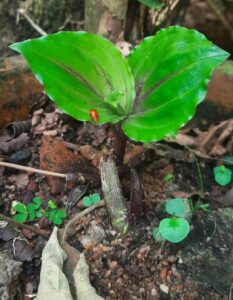TERRESTRIAL ORCHIDS
Two Medicinally important terrestrial orchids of Nagalasery Hills
A terrestrial orchid literally means an orchid that grows in the ground.
Terrestrial orchids have their perennating tissues in the surface substrate of the ground, such as the soil or organic floor of a forest, or the surface sediment or peat of a wet meadows.
One such medicinal important terrestrial orchid is Nervelia aragoana the source for
पदमचारिणि
ഓരിലതാമര
Nervilia aragoana
A 2 cm tall underground pseudobulb in the underbrush of seasonally drier forests. During the growth of the inflorescence that bears 2-3 flowers, the plant has to do without its single egg-shaped or heart-shaped leaf with a showy brown -and -purple marking -the leaf does not develop until after the flowers fade.
· The flowers are about 1 in/ 2.5 cm across; their tepals are greenish yellow with lengthwise brown stripes of varying intensity. The lip is a shade lighter.
· The plant should be grown in a humic substrate in flowerpots. During growth, the plant needs moisture semi -shade, and ample warmth, while requiring absolute dryness and reduced temperatures in the winter. It blooms between January and April.
The various uses in ayurveda as follows.
Ø kaphavatahara useful in Mootrakrichra and different Akshirogas, Rasayana
Ø The synonyms indicates a plant looking like padma in terms of similarity of leaf and spreading nature like lotus under the ground … but growing on land so called Sthalapadma.
Ø It is one of the ingredients of Vatsyamanthakagritha
Ø Kerala traditional Ayurvedic books used this for various urinary disorders and Eye problems
Ø Mootrakrichra : Padmacharini with water or with Tandulodaka and Kadakabeeja bhasma (Yogamritam)
Ø Mootratisara : Padmacharini peya (Yogamritam)
Ø Mootrashmari : Kandha with Dadhimastu (Chikithsakawthukam)
Ø Netrarogas :Dhara of tubers mix with sthanya (Yogamritam, Arogyaraksha kalpadruma)
————————————————————————————————————————-
Another Terrestrial orchid found in Nagalasery Hills is Malaxis Versicolor the source for Jeevaka, one which helps in the sustainability of life.
जीवक
JEEVAKA
ജീവകം, പച്ചിലപെരുമാൾ
Malaxis versicolor
जीवकः कूर्चकाकार
जीवको मधुरः, शृङ्गो, ह्नस्वाङ्गः, कूर्चशीर्षकः
जीवकर्षभकौ बल्यौ शीतौ शुक्रकफप्रदौ |
मधुरौ पित्तदाहास्रकार्श्यवातक्षयापहौ
A terrestrial orchid one of the member of Ashtavarga
· Malaxis versicolor is a terrestrial orchid with short stem, pseudobulb ovoid. Leaves are 2 rarely 3 stalkless or shortly stalkes, ovate to lance-shaped.
· Flowers are borne in densely flowered raceme atop the leafless stem. Bracts are lance-shaped, deflexed. Flowers are small, yellow or purple, lip is short wedge-shaped or kidney-shaped, with comb-like teeth.
These findings pointed towards the importance of local flora survey as mentioned by susrutha Acharya
” Earth is a bed of special divine plants and is known to hold priceless treasures in all places… to find them only thing is we have to observe nature..”…Acharya Susrutha
“नदीषु शैलेषु सरःसु चापि पुण्येष्वरण्येषु तथाऽऽश्रमेषु |
सर्वत्र सर्वाः परिमार्गितव्याः सर्वत्र भूमिर्हि वसूनि धत्ते ||”
(सुश्रुतसंहिता चिकित्सास्थानम्– – 30 chapter)
The Devine plants and other resources has to be searched in the rivers, holy forests, hermitages, hills and ponds. since earth is a bed of jems and is known to hold priceless treasures in all places” – (Susruta Chikithsastana 30th chap)
By,
Prof. Dr. Ajayan SadanandanMD(Ayu), PhD
Head – Ayurveda Ethno Medico Botanical Team
Ashtamgam Ayurveda Chikitsalayam & Vidyapeedham





